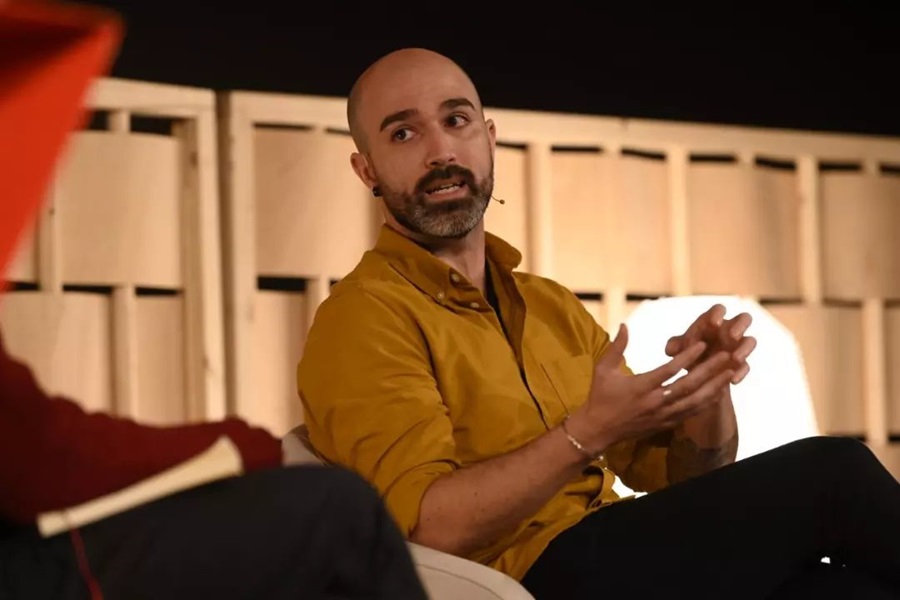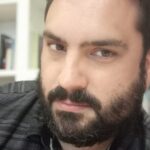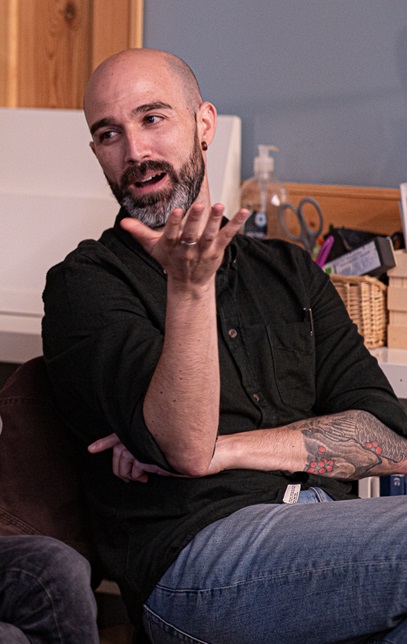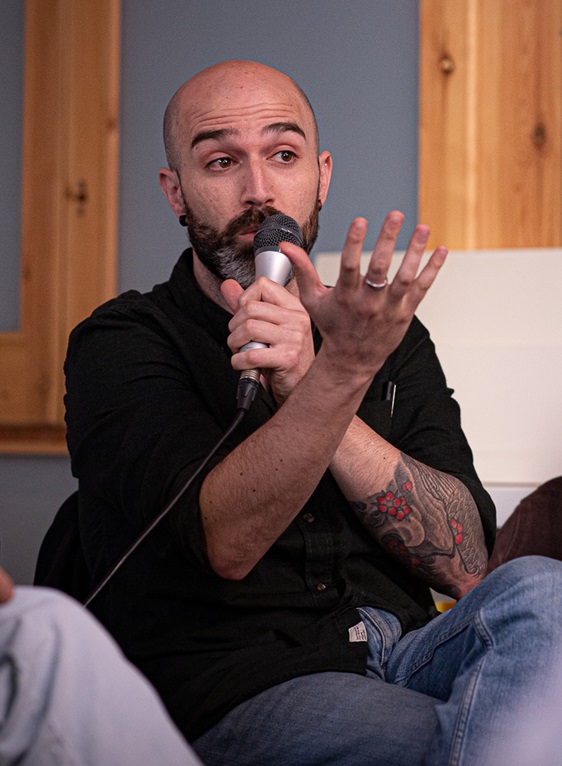- Science
- 3 de June de 2024
- No Comment
- 23 minutes read
José Valenzuela: “Madness is a different way of seeing and relating to the world”

Interview with José Valenzuela, Engineer and PhD in Humanities
José Valenzuela: “Madness is a different way of seeing and relating to the world”


I must confess that I am not familiar with José Valenzuela. It is likely that no label could adequately encompass the breadth of his work. I have heard about him for some time, always mentioned in connection with intriguing artistic and scientific projects. Is he a man of the future who writes about Don Quixote? A Renaissance man specialising in Coetzee and the study of emotions? It is best to let him explain his research to us himself…
You are a Lab Manager in a multidisciplinary laboratory at the University of Barcelona. What does your role entail? What kind of people visit your lab?
Brainlab is a cognitive neuroscience laboratory founded by Dr. Carles Escera, where we investigate various brain mechanisms related to processes such as attention and memory. Most of our research focuses on the auditory system, although our ideas extend into a wide range of different areas. We have researchers working to understand how our brain can identify that a stimulus originated from our own actions. Why might something so simple be of interest? Because it helps us better understand phenomena in conditions like schizophrenia, where sufferers report hearing voices that feel foreign, although we can assume they originate from their own brains. Additionally, we explore how we learn to process sounds and, by extension, language.
“I am currently leading a research to develop artificial intelligence algorithms capable of identifying patterns in brain signals that, due to computational limitations, cannot be detected with traditional statistical methods”
Let me feather my own nest, I am currently leading a research project with a fantastic team of developers (Laura, Albert, if you’re reading this, I appreciate you greatly) to develop artificial intelligence algorithms capable of identifying patterns in brain signals that, due to computational limitations, cannot be detected with traditional statistical methods. Our most cutting-edge project in this field is developing a technology that can detect potential delays in the neurodevelopment of a baby’s language skills with just an EEG (electroencephalography) measurement at birth.
As you can imagine, this work requires a wide range of expertise. Our team includes mathematicians, physicists, engineers, psychologists, biologists, geneticists and doctors. We’ve even collaborated with linguists, philosophers, and archaeologists.
What are “cognitive literary studies”?
I would summarize it by saying that it’s one of my passions, although I suspect that such an irrelevant fact might not be of much help to those unfamiliar with this fascinating line of research. This discipline applies cognitive science, or the study of the mind, to traditional literary theory and narratology. While this may seem revolutionary, it is a natural progression, as literary theory has long been exploring processes and mechanisms intimately connected to the human mind. This field investigates how we become emotionally engaged with a text, the techniques an author employs to transport us to the fictional world they have created, and how we can feel such a personal connection to a story written by someone who may have lived in a different century or on the other side of the globe. I find it fascinating, honestly.
In my doctoral research within this discipline, I examined how J.M. Coetzee is able to elicit profound emotions through two distinct layers: the narrative itself (the story being told) and the stylistic (how it is constructed through textual mechanisms). This exploration led to further reflections that I hope to address in the future: How is it that we can be so deeply moved by events we know to be fictitious, yet remain so indifferent to our immediate reality?
What was your role in the Nanomaterial and Microsystems Group of the Autonomous University of Barcelona?
For nearly four years, I served as a laboratory technician in the group, assisting in the development of various microelectronic systems. These systems were designed to deepen our understanding of the unique characteristics of nanomaterials. Have you heard of graphene? The broom in projects focused on finding applications for this material comes precisely from its characteristics at the nanoscale. For instance, it can be used for more efficient hydrogen storage. When we reduce a material to the nanoscale, its behaviour changes compared to larger, more manageable dimensions. This was the focus of our work. Please excuse my vague explanation, as research topics often involve a degree of confidentiality. Those years presented many exciting challenges, such as achieving precisions of femtoamperes (10-15 amperes) and creating ultra-high vacuum conditions (between 10-7 and 10-12 mbar). It may sound like science fiction, but I wish I could show you some photos of the devices wrapped in aluminium foil.
What is Biomedical Engineering? How did you discover this career path?
Biomedical engineering is a specialized field of engineering that applies engineering principles to the medical sector. This can be in a hospital, a company, or a research laboratory. I chose the latter, although I also spent a few years working in the innovation department of a university hospital. A biomedical engineer might specialize in developing medical imaging machines, analysing physiological signals, or studying biocompatible materials for transplants.
 In my case, from the outset of my career, I was determined to use my engineering skills to benefit society. While this may sound naive, and one could argue that all work indirectly benefits society, I wanted to see a direct link between my work and the individuals it helped. When I began my studies, biomedical engineering did not yet exist as a discipline, so I started with electronic engineering. I later expanded my knowledge with a higher degree in automation, which involves robotics and automatic systems. When the master’s degree in biomedical engineering became available, I had already been working in neuroscience for some time, so it seemed like a logical progression. I am extremely satisfied with the outcome.
In my case, from the outset of my career, I was determined to use my engineering skills to benefit society. While this may sound naive, and one could argue that all work indirectly benefits society, I wanted to see a direct link between my work and the individuals it helped. When I began my studies, biomedical engineering did not yet exist as a discipline, so I started with electronic engineering. I later expanded my knowledge with a higher degree in automation, which involves robotics and automatic systems. When the master’s degree in biomedical engineering became available, I had already been working in neuroscience for some time, so it seemed like a logical progression. I am extremely satisfied with the outcome.
Did one of your research projects involve studying the emotional responses elicited by Christian retreat spaces?
This research is truly intriguing, and I mean that in the most positive sense. After a hiatus from the laboratory during my stint at the hospital and subsequently at a virtual reality lab, I explored various career paths, including teaching at a secondary school. When my wife became pregnant, I sought a position that would allow me to spend as much time as possible with my family. Around this time, an archaeologist from the University of Barcelona initiated a two-million-euro research project and required a neuroscientist. She approached Carles, my current supervisor, who was in need of someone with expertise in neuroscience, engineering, and acoustics. During a casual conversation, we decided it was time for me to return to the lab.
“Certain caves with cave art exhibit unique acoustics compared to similar nearby caves devoid of paintings”
The project, in brief, explores the role of sound in the past. For instance, certain caves with cave art exhibit unique acoustics compared to similar nearby caves devoid of paintings. Some archaeologists hypothesize that Neolithic shamans (we’re discussing hunter-gatherer societies rooted in proto-religions of an animistic nature, where they believed nature possessed a soul) selected these locations for their rituals. The music of drums, bone flutes, and chants, reverberating in these spaces, may have facilitated more profound mystical experiences. They might have felt as though the mountain was responding to them. It’s not difficult to see the parallels with the acoustics of cathedrals or churches, with their high reverberations and echoes. These spaces could induce a trance-like state, often enhanced by the use of substances or techniques such as cold-water immersion or breath control.

Our work plan included visits to numerous global destinations, home to caves with remarkable acoustics. However, the advent of COVID slightly disrupted our plans. One of my colleagues, Samantha, pivoted to conducting the research online, as the acoustics of many places of interest, including churches, are available on the internet. Her work involved convolving music (both liturgical and secular, for comparison) with these acoustics. Convolving means you end up hearing a specific acoustic stimulus (the music) as it would be heard in a particular place (the acoustics). The results indicated that we experience a greater sense of transcendence in the acoustics of these retreat spaces, while the effect of the music piece itself wasn’t as significant. Of course, it’s acknowledged that the experiment’s audiences weren’t the same as those of the time the music was composed, but it’s a step forward.
If I’m not mistaken, one of your research fields involves the relationship between literary creation and mental health disorders…
The realm of madness has always intrigued me as a field of research. These minds process reality in ways far removed from what we understand as normal or conventional, and I’m deeply interested in understanding the mechanisms behind this. Needless to say, I am very interested in learning about it from the perspectives of clinical psychology and psychiatry, but literature and other fictional formats add the creative component of the author. It’s, so to speak, the vision of a mad mind processed by another mind, or sometimes even the artistic creation of that very mad mind. It’s captivating to see what’s inside. Have you seen the outsider art compositions of some psychiatric hospital patients? We shouldn’t think of outsider art as synonymous with mad art, but it has always had a space for it since the term’s inception. The works these individuals create are… hypnotic.
“It’s, so to speak, the vision of a mad mind processed by another mind, or sometimes even the artistic creation of that very mad mind”
According to your Doctoral Thesis, Hacia tierras lejanas. Emoción y cognición en la lectura de ficciones literarias. Un análisis de la narrativa de J.M. Coetzee (Towards Distant Lands. Emotion and Cognition in the Reading of Literary Fictions. An Analysis of J.M. Coetzee’s Narrative), Pompeu Fabra University, 2016, directed by Domingo Ródenas de Moya, the elderly writer once said: “To write a novel, you have to be like Atlas” (p. 302). Could you elaborate this statement?
Many people might better understand this with the classic example of the writer who says a character refused to die when they were writing their ending. Setting aside the fantastical aspect, it makes perfect sense. Writing a novel is, in a way, creating a universe where you conceive an initial state of things and set them in motion. The number of elements will vary with the novel’s complexity, but there will be a good number of beings, places, and moments that will evolve into new states—a dynamic system, so to speak. Thus, the initial idea we have of our characters will expand and perfect as we write them, putting them in different situations and getting to know them better. Coetzee, a master of this art, summed it up wonderfully with the figure of Atlas, that titan carrying the world on his shoulders. The writer, when writing, carries that world on their shoulders, allowing time to pass, relationships between characters to develop, and everything to evolve towards the desired destiny. Whether it reaches that or another will also be a result of that evolution, of course.
What advice would you give to a young Spanish scientist starting their research career?
First, I would say to follow that path if they are truly passionate about research. I’m tired of seeing people make decisions based solely on practical and circumstantial reasons, and although I respect what everyone ultimately chooses, I believe it’s the best way to end up living an unhappy life. Or, let me correct myself: try the research path, and if it doesn’t convince you, leave without any remorse. You don’t have to be a completist here; we only have one life.
“I’m tired of seeing people make decisions based solely on practical and circumstantial reasons, and although I respect what everyone ultimately chooses”
That said, and being more practical, I would tell them to be prepared to travel abroad for a few years, and perhaps stay there. If they choose not to travel too far and stay here, they’ll need to develop a good political sense because they’ll have to earn their position with tools that won’t always be the obvious ones (and by obvious, I mean academic merits, publications, etc.). It’s sad to say, but in many departments of many universities, appointments and hiring processes still operate not quite arbitrarily, but almost. I’ve seen cases where a candidate with an impressive profile was left looking like a fool when someone with barely any experience beyond a few classes given at the faculty was chosen over them. It’s sad. And faced with that, either you fight for change, which would be ideal, or you learn to adapt and carve out your future. My younger self, much more idealistic, would have said it’s either the first option or nothing; my current self, who sees everything from a technical and pragmatic perspective, would say that in this life, you have to be savvy and that you can fight for a better society with a hot meal and a roof over your head. And let everyone interpret that as they see fit.
Oh, and I would also tell them to value our circumstances as a country. That is, to understand that a Spanish researcher, when going abroad, tends to demonstrate many more skills than others, if they are competent. The reason? We have to manage with fewer resources. It sounds like a joke, but many former lab colleagues told me they had to program their experiments and carry them out with less advanced (if not obsolete) equipment. Suddenly, they arrived at American labs where the technology is like science fiction, and people who learned in those environments barely know how to request things, but not how to do them. Something good had to come out of it.
What did you discuss with writer Vicente Luis Mora in December 2023?
These sessions focused on cognitive literary studies, where we explored different ways to combine disciplines to approach this type of research, ranging from purely theoretical to highly applied methods, such as analysing brain signals or Magnetic Resonance Imaging during the reading of a work.
“I addressed topics such as how narrative texts can provoke real emotions, the different types of emotions”
For my part, I introduced the discipline and aimed to present as many relevant questions as possible rather than discussing my own research in depth. I addressed topics such as how narrative texts can provoke real emotions, the different types of emotions, and the importance of indeterminate spaces in a story and how we fill them with our own experiences, making reading an intimate, receptive act. I even dared to link homeostasis—the tendency of living organisms to seek optimal conditions for survival—with the birth of culture and, by extension, the reading of fiction.
Vicente Luis, on his side, delighted us with the reading of an essay in which he identified various ways contemporary Spanish literature authors portray memory processes. It was magnificent to present to the audience an ideal example of research in this fascinating study field. And well, I had the chance to give Vicente Luis a long-overdue hug. I admire him greatly.
Why did you become an engineer? How did you end up in a Humanities Doctorate?
I became an engineer because I’ve always been obsessed with understanding how everything works and I love science, mathematics, and new technologies. My simple idea was to design or create machines that could help people like my granny. That made me choose electronic engineering, although, as I mentioned earlier, I gradually shifted towards biomedical engineering, which aligns more with my interests.
“I discovered literary theory, especially the branches focused on phenomena associated with reading, which were very close to the study of the mind”
Curiously, when it was time to choose a baccalaureate, I wasn’t sure whether to opt for the technological or the humanistic path. I also considered studying journalism because I love writing. A good teacher advised me that if I chose engineering, I could always write later, whereas the reverse would make it difficult to study complex subjects like double integrals or Laplace transforms. And she was right. After completing various engineering degrees, I decided it was time to rediscover my humanistic side. I started building a broader library, as my reading had been limited to fantasy and science fiction, which is great but I felt the need to explore other genres. I then began a master’s degree in literary creation. It was there that I discovered literary theory, especially the branches focused on phenomena associated with reading, which were very close to the study of the mind. I spoke with Domingo Ródenas, the then-coordinator of the master’s programme, and we found common interests. This led to my doctorate with Domingo as my supervisor.
What is consciousness?
Wow! That’s a big question. I’ll start by saying, as a cautious person, that I can’t fully answer that question since I lack knowledge in areas like philosophy. My approach has always been from neuroscience and psychology. From there, I can say that if I had to summarise the complexity of the concept of consciousness in a few words, I would say that consciousness (I won’t delve into debates about whether it’s consciousness or awareness; we understand what we’re talking about in this context) is the epiphenomenological result of brain activity (i.e., it arises from it) that allows us to recognise ourselves internally through thought or introspection and also recognise ourselves in relation to the moment and place we are in, as well as everything else that isn’t part of that self. In other words, consciousness allows us to realise who we are and what we aren’t and to think about it. Although I’ve always preferred to summarise it as a fiction we create to understand this mix of internal states, external perceptions, and other bodily (and brain, of course, which is still part of the body) activities. We tell ourselves stories and we tell ourselves where we are.
“Consciousness allows us to realise who we are and what we aren’t and to think about it”
Why Coetzee and Lovecraft?
Coetzee is an author who encompasses many in one. His versatility in constructing all kinds of works, some in the form of a classic novel and others purely experimental, is exceptional and rarely seen in literary history. His style has evolved over the years to carry a prose worthy of being an heir to Beckett’s, one of his greatest influences, achieving what the Irish master sought by stripping style of all the non-essential to leave only the essential. Moreover, his way of delving into the complexities of the human being and their emotions, moving us with the stories he builds, is unique.
Lovecraft fascinated me from the beginning (as I suppose most of his followers) for his ability to create a complex universe full of cosmic creatures and other indescribable beings. Additionally, his skill in creating terrifying atmospheres, not only through the obvious but also through the psychological aspect, left me astounded from the first stories I read, which, as you can guess, were the Cthulhu Mythos. It’s very difficult to confront the insignificance of the human being with the immensity of our universe (or universes), and I think Lovecraft did it brilliantly.
What are you reading lately?
I read less than I would like because my second child was born four months ago, and well, you know how it is. But I try to read a bit of everything, within the significant interest I have in postmodernist literature. Or metamodernist, a term I discovered relatively recently thanks to my friends at Mutatis Mutandis, and I’ve developed a small obsession with trying to identify works that could fit that concept. David Foster Wallace, series like Atlanta or Fleabag, and my God on earth, Charlie Kaufman, would be paradigmatic examples.

But I’m beating around the bush. Right now, I’m reading La península de las casas vacías by David Uclés (Siruela), a work with excellent prose that builds a story full of magical realism that I’m loving and would recommend to anyone who wants to read something about the Civil War from a very original and tender perspective in its treatment of the characters. I’m also reading Todas las familias felices by Hervé Le Tellier (Seix Barral), recommended by Joan Flores Constans, my favourite Francophile, because he knows my father went out for a pack of cigarettes when I was a kid and never came back, and it’s a topic that moves me (and therefore interests me). Joan has a theory that the narratives of authors who have been abandoned or are orphans are recognisable in certain traits. And he nailed it with the recommendation. I identify with every page, even though the author’s life and mine are nothing alike.
I can’t stop recommending Grimmish by Michael Winkler (Mutatis Mutandis) because it’s a crazy, unclassifiable book. Yes, it seems to be the biography of a boxer, Joe Grim, who became famous for never winning a fight but never being knocked down. But then it erupts into a chronicle of the chronicle, shifting into fiction, interspersed with reflections on literary theory, and culminating in a foul-mouthed goat discussing physical pain. It’s a wild, read for daring readers, without a doubt.
And I can’t recommend highly enough any novel or story by Laura Fernández. Leaving aside her highly characteristic and recognizable style, she has an imagination that I wish I had. She reminds me of manga artists or Japanese authors like Yasutaka Tsutsui, who seem to have no limits when proposing characters, themes, or situations, no matter how impossible they may seem at first. That’s a gift.
What is madness? Does it exist?
I see you want to make me sweat until the last question. What a topic, madness. I wrote a comic about it, and I’m still not sure how to define it, although I really liked the way Laura Martín from the “Revolución Delirante” explains it, which I’ll slightly modify: madness is a different way of seeing and relating to the world.
What I will say is that I don’t like using madness as a synonym for mental illness because it reduces all the complexity of the former (which should encompass philosophical, social, psychological aspects…) to the biologicism of the latter. I also don’t want it to be understood that I’m saying mental illness doesn’t exist because I don’t think that at all. (Sorry for being so precise, but in the subject of madness, language is everything). That said, I would say that madness exists as long as we try to define or capture it with words. I know it’s a bit of a tricky answer because, that way, madness will always exist, although with different forms, as we redefine it over time. But I think that’s what makes the term so interesting because it ties it to each era and society. Isn’t it crazy?
Source: educational EVIDENCE
Rights: Creative Commons

